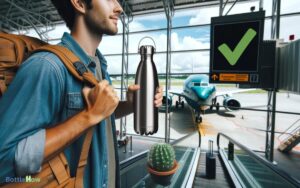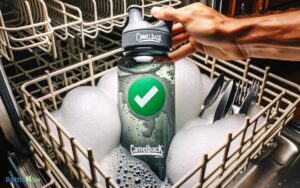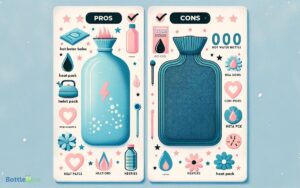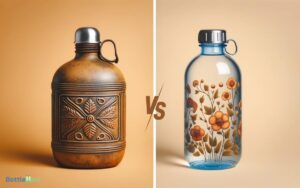Are Water Bottle Filling Stations Sanitary? A Guide
Water bottle filling stations can be sanitary if maintained correctly. They meet stringent water safety standards and often have built-in filters to remove contaminants.
However, concerns include bacteria and viruses on touch surfaces. High-traffic usage can lead to pathogen buildup, mitigated by regular cleaning and touchless features.
Routine maintenance, including filter replacements and daily disinfection with EPA-approved products, is essential. User behavior such as avoiding spout contact and using clean bottles also minimizes risks.
With these protocols, filling stations offer a hygienic solution for hydration—you’ll find insights on ensuring their safety continues.
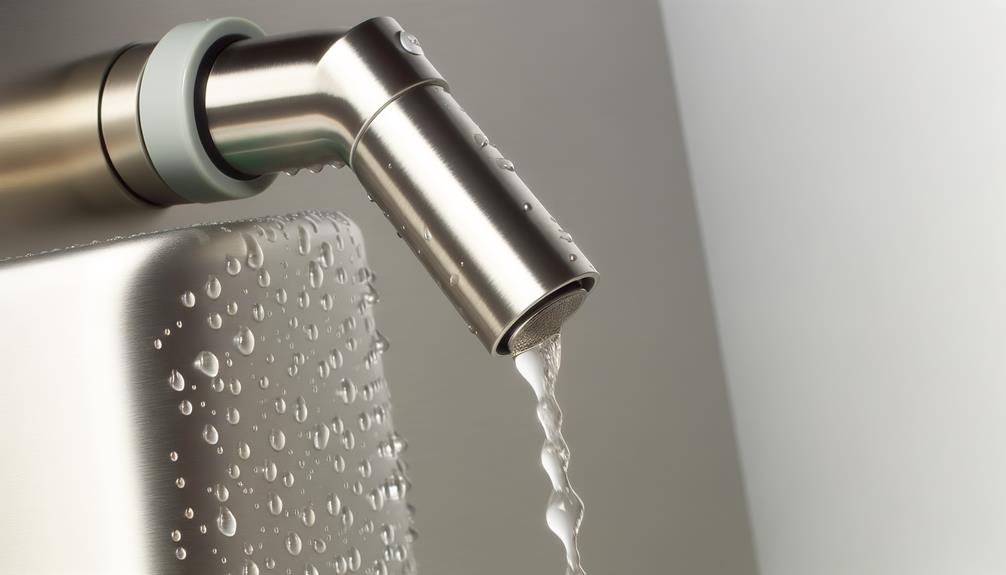
Key Takeaways
- Regular cleaning and maintenance are crucial to ensuring the sanitation of water bottle filling stations.
- High-touch surfaces can harbor pathogens, but touchless designs significantly reduce contamination risk.
- Built-in filters in filling stations remove contaminants, maintaining high water quality.
- User behavior, like avoiding touching spouts and using clean bottles, greatly impacts cleanliness.
Understanding Water Bottle Filling Stations
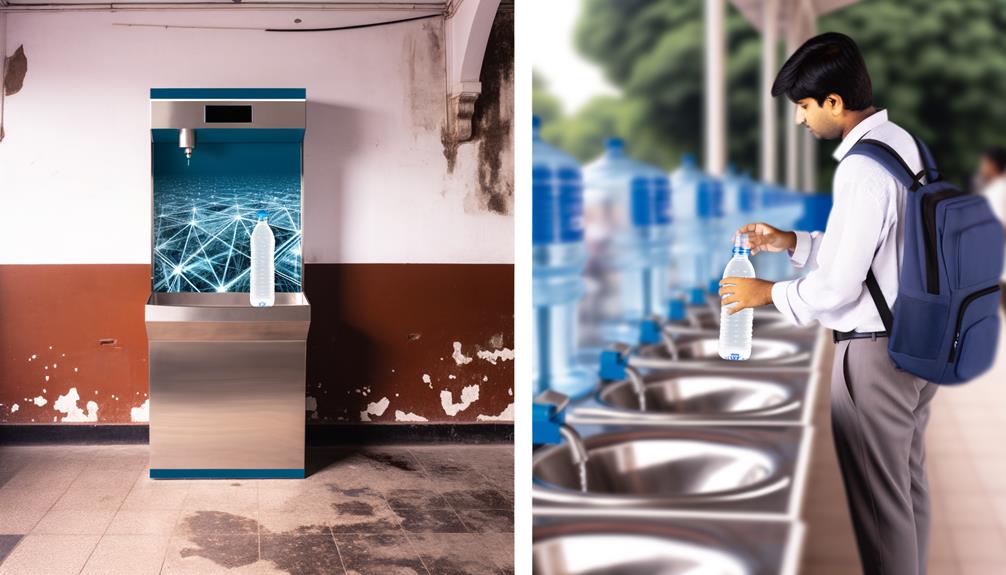
Water bottle filling stations are designed to provide a convenient and eco-friendly way to refill reusable bottles with potable water.
They’re often installed in public places like schools, airports, and gyms. Data shows that these stations considerably reduce plastic waste by encouraging the use of reusable bottles.
The water dispensed meets stringent safety standards, ensuring it’s safe for consumption. Risk assessments indicate that the stations typically have built-in filters to remove contaminants, offering an added layer of protection.
Additionally, touchless features mitigate the risk of cross-contamination. By understanding the functionality and safety measures in place, you can confidently use these stations knowing they’re designed with both convenience and health in mind.
Common Hygiene Concerns
Despite the safety measures in place, it’s important to address common hygiene concerns that users might have about water bottle filling stations.
One major worry is the potential for bacteria and viruses on the surfaces you touch, such as the spout and button. Studies indicate that high-traffic areas can harbor pathogens, but regular cleaning protocols notably reduce this risk.
Another concern is cross-contamination from improper use, like touching the spout with your bottle. Data shows that most modern stations are designed to minimize contact, often featuring touchless operation.
Types of Contaminants
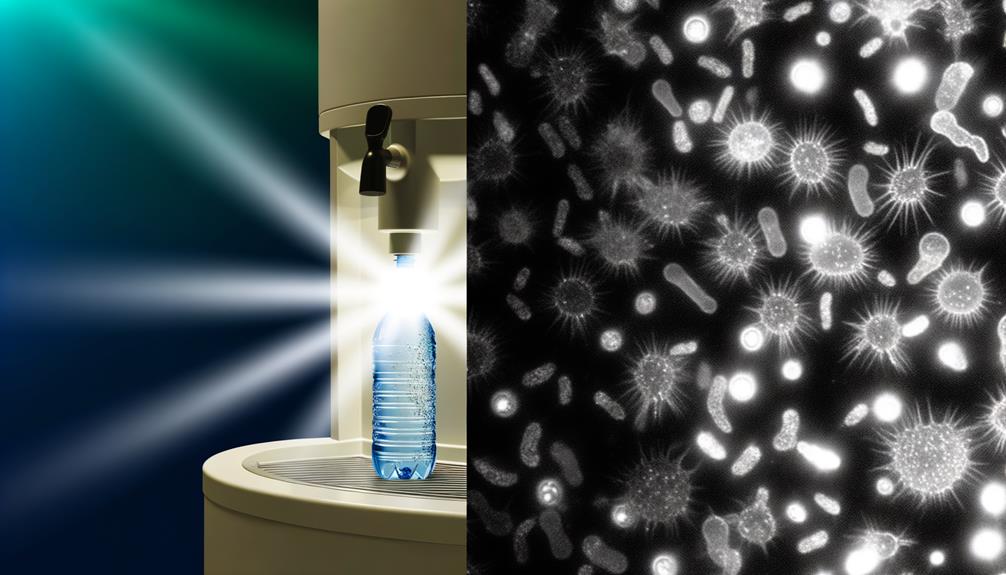
In public water bottle filling stations, you may encounter various types of contaminants, including bacteria, viruses, and chemical residues. These contaminants can pose health risks if not properly managed. Here are four primary contaminants to be aware of:
- Bacteria: Pathogenic bacteria like E. coli can cause gastrointestinal illnesses.
- Viruses: Norovirus and other viruses can lead to severe stomach flu symptoms.
- Chemical Residues: Contaminants like lead or chlorine may leach into water from pipes or cleaning agents.
- Biofilms: These microbial communities can form on surfaces and harbor pathogens.
Understanding these risks helps you make informed decisions about using these stations.
Regular maintenance and monitoring are essential to minimize contamination and guarantee safe drinking water.
Design and Cleanliness
Guaranteeing the design and cleanliness of water bottle filling stations is essential in minimizing contamination risks and maintaining sanitary conditions.
The design should feature touchless operation to reduce contact points and potential microbial transmission. High-quality, non-porous materials like stainless steel are recommended since they resist bacterial growth. Additionally, stations should include proper drainage systems to prevent water stagnation, which can harbor pathogens.
Data shows that frequent cleaning with EPA-approved disinfectants considerably lowers contamination levels. Regular microbial testing of surfaces can provide a risk assessment to identify potential problem areas.
Maintenance Protocols
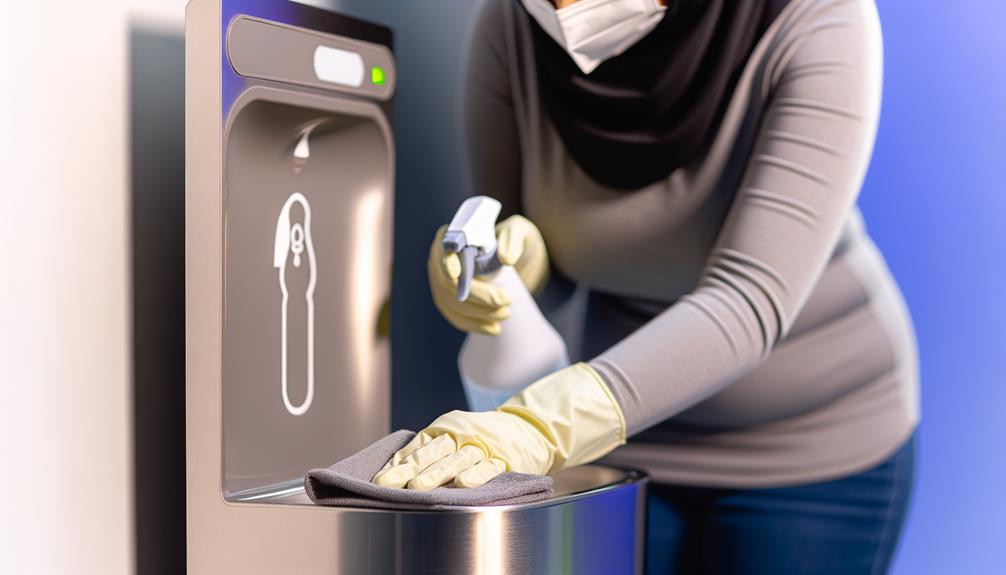
To maintain the sanitary integrity of water bottle filling stations, it’s crucial to establish rigorous maintenance protocols that include routine inspections, cleaning schedules, and timely repairs.
You should focus on the following key areas:
- Routine Inspections: Conduct daily checks to identify any signs of contamination or malfunction.
- Cleaning Schedules: Implement a detailed cleaning plan, using EPA-approved disinfectants, to guarantee all surfaces and internal components remain hygienic.
- Filter Replacements: Replace water filters according to manufacturer guidelines to guarantee peak water quality and prevent bacterial buildup.
- Timely Repairs: Address any mechanical issues promptly to minimize downtime and maintain operational efficiency.
Impact of User Behavior
You play an essential role in the sanitation of water bottle filling stations through your usage habits.
Improper practices, like touching the spout with your bottle, can introduce contaminants.
Proper Usage Habits
Frequently, the sanitation of water bottle filling stations hinges greatly on the behavior and habits of their users. Your actions can notably impact cleanliness and hygiene. For instance, avoiding direct contact between the bottle’s mouth and the dispenser can help reduce contamination. Additionally, regularly cleaning your bottle with appropriate solutions, such as using a denture cleaner for water bottles, can effectively remove bacteria and residue buildup. By adopting these simple practices, users contribute to maintaining a more hygienic and sanitary environment for everyone.
Here are four key habits to adopt:
- Avoid Touching the Spout: Direct contact with the spout can transfer germs, increasing contamination risk.
- Use Clean Bottles: Always use bottles that have been thoroughly cleaned and sanitized to prevent introducing bacteria.
- Report Issues: If you notice any leaks or malfunctions, report them immediately to guarantee prompt maintenance.
- Time Your Refills: Refill your bottle during off-peak times to reduce your exposure to potentially contaminated surfaces.
Adopting these habits can mitigate risks and promote better hygiene at water bottle filling stations.
Common Contamination Risks
User behavior greatly impacts the common contamination risks associated with water bottle filling stations.
When you touch the nozzle directly with your bottle, bacteria and viruses can transfer to the station, increasing the risk of spreading pathogens.
Studies have shown that up to 25% of public water stations harbor harmful microorganisms.
Additionally, failing to wash your hands before using the station can introduce contaminants.
Droplets from coughing or sneezing near the station may also pose risks.
It’s important to avoid these behaviors to minimize contamination.
Using a clean, well-maintained bottle and practicing good hygiene can considerably reduce exposure to harmful bacteria.
Hygiene Maintenance Practices
Adopting proper hygiene maintenance practices, such as regular cleaning of the filling stations and guaranteeing minimal direct contact with the nozzle, greatly reduces contamination risks. By adhering to these practices, you can greatly mitigate the spread of harmful pathogens.
Consider these four key practices:
- Regular Cleaning: Daily cleaning of the stations helps prevent biofilm buildup and pathogen proliferation.
- User Education: Informing users to avoid touching the nozzle can minimize contamination.
- Sanitization Stations: Providing hand sanitizers near the filling station encourages users to clean their hands before use.
- Routine Inspections: Periodic checks guarantee the stations are functioning properly and remain hygienic.
Implementing these measures guarantees a safer and more sanitary water bottle filling experience.
Benefits of Using Filling Stations
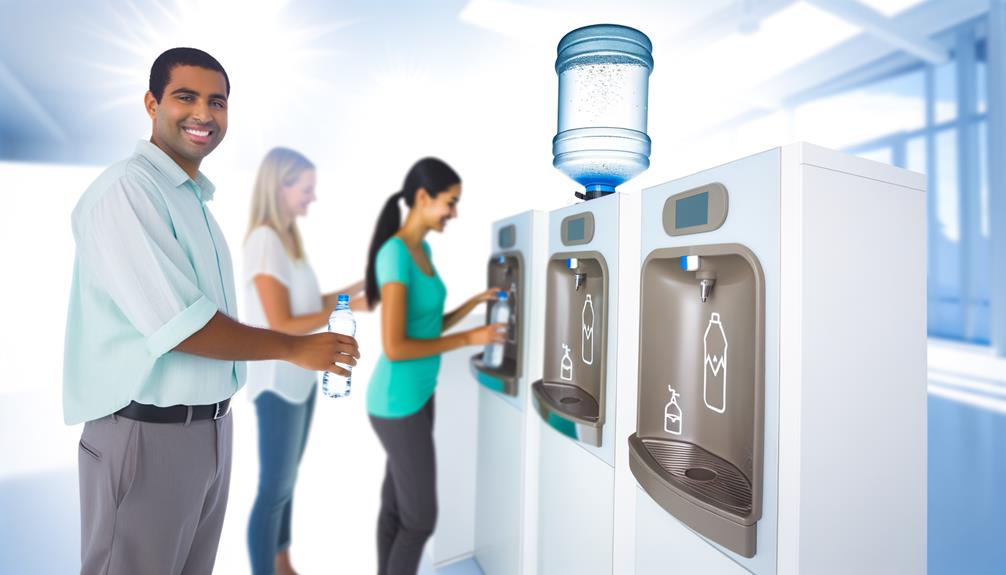
Using water bottle filling stations can greatly reduce environmental impact by cutting down plastic waste; studies show that one filling station can save thousands of plastic bottles annually.
They’re also cost-efficient, potentially saving you money compared to purchasing bottled water.
In addition, easy access to clean water encourages regular hydration, which is essential for maintaining ideal health.
Environmental Impact Reduction
By choosing water bottle filling stations, you can greatly reduce plastic waste and mitigate environmental damage. Here’s how:
- Reduced Plastic Production: Each refill eliminates the need for single-use plastic bottles, cutting down on the 8 million metric tons of plastic entering oceans annually.
- Lower Carbon Footprint: Manufacturing plastic bottles releases greenhouse gases. Refilling stations help reduce this carbon footprint.
- Waste Management Efficiency: Fewer plastic bottles mean less strain on recycling systems and landfills, which are often overwhelmed.
- Conservation of Resources: Producing plastic bottles uses significant amounts of water and fossil fuels. Filling stations reduce this resource consumption.
Cost-Efficiency
Water bottle filling stations offer significant cost savings by reducing the need for purchasing single-use plastic bottles. When you shift to using filling stations, you’ll see a noticeable decrease in expenses tied to bottled water. This cost-effectiveness is backed by data, as illustrated in the table below:
| Cost Category | Single-Use Bottles | Filling Stations |
|---|---|---|
| Initial Investment | Low | Moderate |
| Cost per Liter | $1.00 | $0.003 |
| Annual Expenditure | High | Low |
| Environmental Fees | High | Low |
| Maintenance Costs | None | Moderate |
This table highlights the long-term financial benefits. While the initial investment in filling stations is moderate, the ongoing costs are minimal. Ultimately, you’ll find that filling stations are a cost-efficient and sustainable choice for hydration needs.
Encourages Hydration
Filling stations greatly boost daily water intake, supporting ideal hydration levels and overall health. By making water more accessible, they encourage you to drink more frequently, which is essential for maintaining bodily functions.
Here are four key benefits:
- Improved Cognitive Function: Studies show that staying hydrated can enhance concentration and cognitive performance.
- Enhanced Physical Performance: Adequate hydration improves endurance and reduces fatigue during physical activities.
- Better Skin Health: Drinking more water helps maintain skin elasticity and reduces the risk of dryness.
- Efficient Waste Removal: Proper hydration aids in kidney function, promoting effective waste removal from your body.
Incorporating these stations into daily routines can considerably impact your hydration and overall well-being.
Safety Measures to Adopt
To guarantee the sanitation of water bottle filling stations, adopt rigorous cleaning protocols and regularly test for microbial contamination.
Clean stations daily using EPA-approved disinfectants, focusing on high-touch areas like spouts and buttons.
Implement a routine maintenance schedule to inspect filters, replace them as needed, and confirm proper function.
Utilize ATP (adenosine triphosphate) testing to measure cleanliness levels, providing immediate feedback on sanitation efforts.
Regularly collect water samples to test for bacteria such as E. coli and Legionella, confirming they meet safety standards.
Encourage users to avoid direct contact between the bottle mouth and dispenser to minimize cross-contamination.
Expert Opinions and Studies
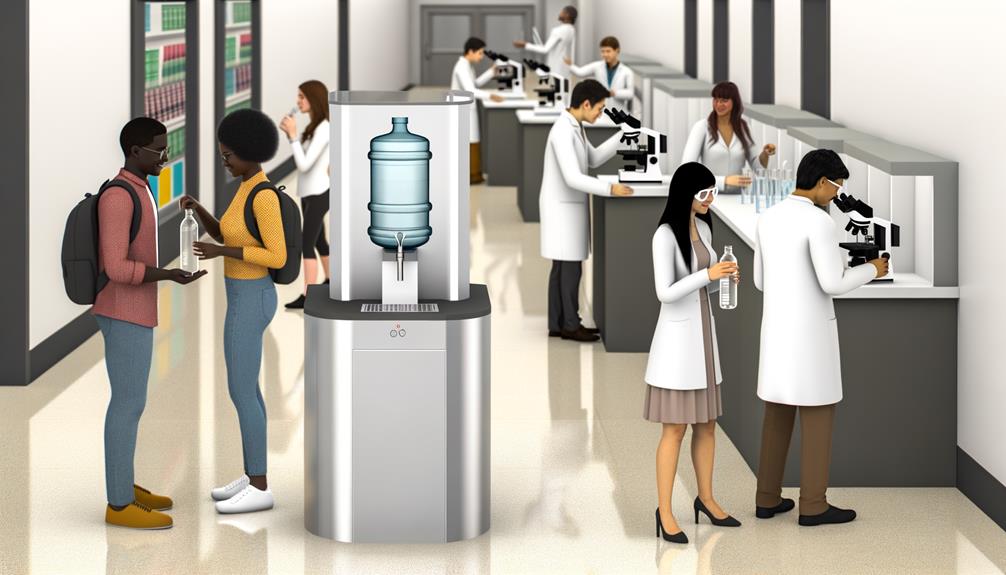
Drawing on recent research, experts emphasize the importance of rigorous maintenance protocols to guarantee the sanitation of water bottle filling stations. They note that without proper upkeep, these stations can become breeding grounds for harmful bacteria and viruses.
Key findings from studies suggest you should consider the following:
- Routine Cleaning: Confirm daily or weekly cleaning schedules to remove contaminants.
- Filter Replacement: Change filters regularly as specified by the manufacturer to maintain water quality.
- Surface Disinfection: Regularly disinfect high-touch areas to prevent microbial build-up.
- Water Testing: Conduct periodic water quality tests to detect and address potential contamination.
Conclusion
In the grand tapestry of public health, water bottle filling stations stand as a beacon of convenience and sustainability.
While they can harbor unseen contaminants, diligent maintenance and responsible user behavior are your shield against potential risks.
Studies affirm that with proper protocols, these stations are generally sanitary.
So, quench your thirst wisely—embrace the benefits, but stay vigilant.
Your health is a precious drop in the ocean of well-being.

